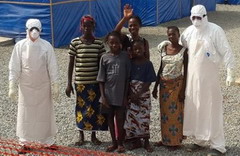 Ebola virus (EBOV) can persist in immunologically protected body sites in survivors of Ebola virus disease, creating the potential to initiate new chains of transmission. From the outbreak in West Africa during 2014–2016, we identified 13 possible events of viral persistence–derived transmission of EBOV (VPDTe) and applied predefined criteria to classify transmission events based on the strength of evidence for VPDTe and source and route of transmission. Read more on Ebola Virus Infection Associated with Transmission from Survivors…
Ebola virus (EBOV) can persist in immunologically protected body sites in survivors of Ebola virus disease, creating the potential to initiate new chains of transmission. From the outbreak in West Africa during 2014–2016, we identified 13 possible events of viral persistence–derived transmission of EBOV (VPDTe) and applied predefined criteria to classify transmission events based on the strength of evidence for VPDTe and source and route of transmission. Read more on Ebola Virus Infection Associated with Transmission from Survivors…
Filed under Apoyo bibliográfico by on abr 15th, 2019. Comment. ![]()
BACKGROUND:
While a number of predictors for Ebola mortality have been identified, less is known about post-viral symptoms. The identification of acute-illness predictors for post-viral symptoms could allow the selection of patients for more active follow up in the future, and those in whom early interventions may be beneficial in the long term. Studying predictors of both mortality and post-viral symptoms within a single cohort of patients could also further our understanding of the pathophysiology of survivor sequelae. Read more on Surviving Ebola: A historical cohort study of Ebola mortality and survival in Sierra Leone 2014-2015….
Filed under Apoyo bibliográfico by on mar 15th, 2019. Comment. ![]()
Since 1976, in more than 40 recorded outbreaks to date, Ebola virus disease (EVD) has dramatically affected the human population across the Central African region and adjacent areas. The large West African outbreak (2013–2015) was a game changer in many aspects, not only with regard to geographical location and the number of patients and deaths, but also in terms of the international community’s response it finally triggered; albeit belatedly so. The progress made in our epidemiological and clinical understanding of the disease was immense, as well as advances in the development of an effective vaccine (e.g. rVZV-ZEBOV), specific therapeutic options (e.g. monoclonal antibodies, convalescent whole blood), and candidates for post-exposure prophylaxis (e.g. Favipiravir) [ ]. Read more on Ebola 2018 – Implications for travel health advice and relevance for travel medicine…
Filed under Apoyo bibliográfico by on feb 3rd, 2019. Comment. ![]()
El primer brote de ébola que se produjo en 2018 en la República Democrática del Congo en la provincia de Equador se saldó a finales de julio con 54 casos, de los que se confirmaron 38 y 16 fueron catalogados como probables, con 33 muertes registradas y 17 casos confirmados. La novedad en este brote en RDC ha sido la aplicación de la vacunación en anillo por parte de MSF y la OMS con la vacuna experimental rVSVDG-ZEBOV-GP, ya probada en África Occidental en el brote de 2014-2016. En total 3199 personas, entre trabajadores de primera línea, los contactos y los contactos de contactos, recibieron la vacuna experimental contra el ébola.
Read more on Anuario 2018: El brote de ébola en el Congo alcanza ya los 500 casos confirmados…
Filed under Actualización by on ene 3rd, 2019. Comment. ![]()
 En el año 2016, Guinea, Liberia y Sierra Leona lograron detener la epidemia más larga de la enfermedad del virus del Ébola en la historia mundial. El control de la epidemia se logró principalmente mediante la implementación de medidas de salud pública efectivas y coordinadas que involucraron la identificación rápida, el aislamiento de casos, el rastreo y aislamiento de los contactos. Read more on Prevención de la enfermedad del virus del Ébola mediante vacunas: dónde estamos en el 2018…
En el año 2016, Guinea, Liberia y Sierra Leona lograron detener la epidemia más larga de la enfermedad del virus del Ébola en la historia mundial. El control de la epidemia se logró principalmente mediante la implementación de medidas de salud pública efectivas y coordinadas que involucraron la identificación rápida, el aislamiento de casos, el rastreo y aislamiento de los contactos. Read more on Prevención de la enfermedad del virus del Ébola mediante vacunas: dónde estamos en el 2018…
Filed under Terapeútica by on ago 23rd, 2018. Comment. ![]()


